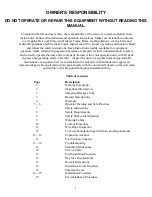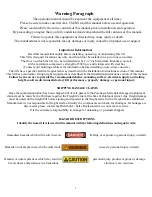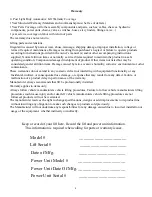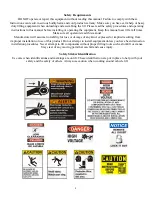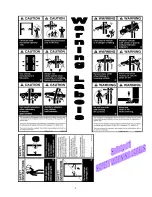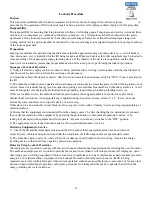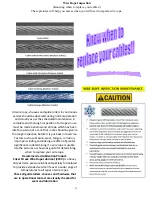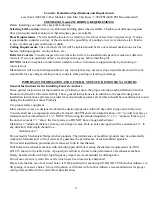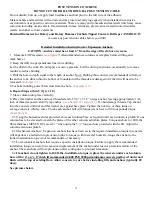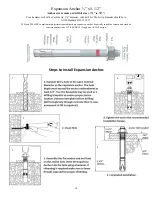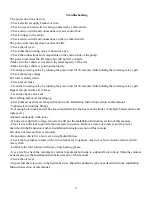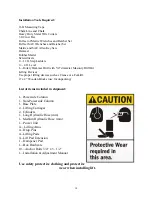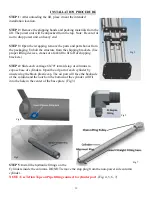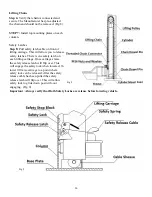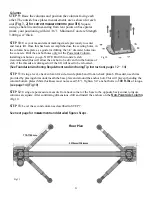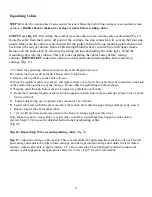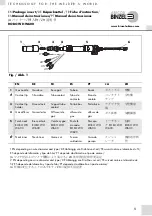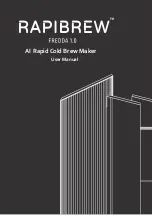
7
Safety Instructions:
1. Do not raise a vehicle on the lift until the installation is completed as described in this manual.
2. Technicians should be trained to use and care for the lift by familiarizing themselves with the publications
listed above. The lift should never be operated by an untrained person.
3. Always position the lifting arms, ramps , adapters and accessories properly out of the way before pulling the
vehicle into or out of the bay. Failure to do so could damage the vehicle and/or the lift.
4. Positioning the vehicle is very important. Only trained technicians should position the vehicle on the lift.
Never allow anyone to stand in the path of the vehicle as it is being positioned.
5. Position the lifting arms, ramps , adapters and accessories to the vehicle manufacturer’s recommended pickup
points. Raise the lift until contact is made with the vehicle. Make sure that the lifting arms, ramps , adapters and
accessories have been properly engaged the vehicle before raising the lift to a working height.
6. Do not overload the lift. The capacity of the lift is shown on the cover of this document and on the lift’s
serial number tag.
7. Keep everyone clear of the lift when the lift is in operation, the locking mechanism is disengaged, or the
vehicle is in danger of
falling.
8. Never override the mechanical workings or components of lift.
9. Unauthorized personnel should never be in the shop area when the lift is in use.
10. Inspect the lift daily. The lift should never be operated if components are damaged or malfunctioning. Only
qualified technicians should service the lift. Replace damaged components with manufacturer’s certified parts.
11. Keep the area around the lift clean and free of debris.
12. Use additional lifting equipment or stands when removing or installing heavy vehicle components.
13. Avoid rocking of the vehicle when it is on the lift.
14. Large vehicles, such as limousines, RV’s, and long wheelbase vehicles, may not be suitable for lifting on
this equipment.
15. Warning reduce the risk of personal injury, keep hair, loose clothing, fingers, and all body parts away from
moving parts.
16. Warning reduce the risk of electric shock, do not use the lift when wet. The lift should not be exposed to the
rain.
17. Warning reduce the risk of fire, do not operate equipment in the close proximity of open containers
containing
flammable liquids (example: Gasoline, flammable solvents).
18. Use the lift only as described in this manual. use only manufacturer’s recommended attachments.
19. Anyone who will be in the vicinity of the lift when it is in use should familiarize themselves with following
Caution, Warning, and Safety related decals supplied with this lift and replace them if the are illegible or
missing:
20. Anyone who will be in the vicinity of the lift when it is in use should read and refer to publications supplied
with this lift:
21. The troubleshooting and maintenance procedures described in this manual can be done by the lift’s owner/
employer. Any other procedure should only be performed by trained lift service personnel. These restricted
procedures include, but are not limited to, the following: cylinder replacement, carriage and safety latch
replacement, arm
replacement, overhead structure replacement.
Summary of Contents for QJY240C
Page 9: ...9...
Page 23: ...23 Fig 12 Fig 12...
Page 32: ...34 Parts Diagram...
Page 33: ...35 Parts List...
Page 34: ...36 COMPANY INFO BACK PAGE...


